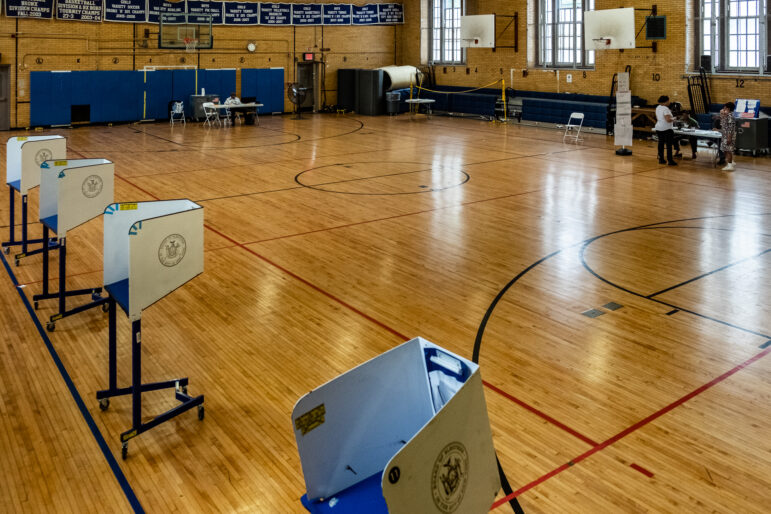“An analysis of voter turnout by the New York City Campaign Finance Board found that from 2008 to 2018, only 3 percent of registered voters cast their vote in every election in which they were eligible. More than a fifth of registered voters did not turn out to vote in any election in which they were eligible to vote.”

Adi Talwar
A polling station located in the Christopher Columbus High School Gymnasium during the June 27 primary.Last month, voters were asked to select City Council candidates in a primary election during a truly off-off-year election. The City Council is usually on the ballot every four years, but redistricting led to this additional election just two years after the last Council races. In 2022 New York voters had to turn out to the polls three times, including an additional primary, because the redistricting process for congressional and state races was caught up in a legal fight.
So perhaps it is not surprising that turnout on June 27 barely cracked double-digit percentages. An analysis of voter turnout by the New York City Campaign Finance Board found that from 2008 to 2018, only 3 percent of registered voters cast their vote in every election in which they were eligible. More than a fifth of registered voters did not turn out to vote in any election in which they were eligible to vote.
Another recent analysis provides a roadmap toward boosting these numbers. GoVoteNYC—a collaboration of more than a dozen foundations and donors—makes grants and gives technical assistance to nonprofit coalitions and associations to build civic engagement and increase voter turnout. An evaluation of GoVoteNYC’s work over the past two election cycles shows that progress is possible.
GoVoteNYC targeted funding to organizations such as Faith in New York and the New York Immigration Coalition that have the trust of their communities. These GoVoteNYC nonprofit partners successfully engaged people who had not been voting: 61 percent of people contacted by the Hispanic Federation had not voted in the last three primaries, while 71 percent of voters contacted by the Asian American Federation did not have a recent history of voting.
GoVoteNYC grantee partners increased voter participation among community members they contacted. During the June 2021 primaries, 37 percent of Black, Indigenous, and People of Color (BIPOC) voters who were canvassed by GoVoteNYC nonprofit partners turned out at the polls, a much higher rate than the 20 percent turnout among voters in those groups who were not canvassed.
What lessons can we learn from these results?
Build relationships
First, GoVoteNYC grantee partners demonstrated the importance of educating communities about how government operates, explaining the ins and outs of the electoral process, and understanding how it all connects to the issues they care about. They used that engagement as an entry point for conversation on voting, rather than the more transactional approach of simply asking people to vote.
GoVoteNYC grantee partners demonstrated the strongest success using these relational voter outreach methods: talking directly about the importance of voting with their constituents, who are then encouraged to talk with friends and family members. In the general election of November 2022, this relational engagement generated the highest turnout among canvassed voters (42 percent), compared to text messages (31 percent), door-knocking (33 percent), and phone calls (27 percent).
Connect and embed
Second, voter turnout work was most successful when embedded into existing programming and building on longstanding relationships. Grantee partners such as United Neighborhood Houses found that by integrating voter education into regular programming across their network of settlement houses, they reached more people, and that turnout efforts were sustained. For example, Hudson Guild ran a Vaccine Hub in Chelsea where staff used the 15-minute period when community members waited after a COVID vaccination to have one-on-one conversations with potential voters about the upcoming elections, and have them sign a pledge-to-vote card.
Include some humanity
In any evaluation, it is also important to take stock of what doesn’t work. GoVoteNYC worked with Columbia University Professor Don Green to conduct a series of experiments, comparing turnout rates between a control group and a random sample of voters contacted via text and phone. The experiments affirmed what any New Yorker barraged by texts at election time might guess: there was no meaningful increase in turnout resulting from mass texts. Relational human-to-human contact is the way to go.
With this recipe for future success, the GoVoteNYC collaborative is now focused on increasing voter turnout in the 2025 citywide elections and has announced a new round of grants to build on these proven methods.
At a time of concern about the future of the country’s democratic processes, it is inspiring that New York’s democracy is being reinforced and rebuilt by community groups using local experience and one-to-one engagement with friends, family, and constituents. It’s the kind of approach that will not just increase voter turnout, but also bring us all closer together.
Martha King is a senior program officer at the Charles H. Revson Foundation. Patricia A. Swann is senior program advisor at the New York Community Trust. Zabrina Collazo is a program officer at the New York Foundation.* The co-authors are co-chairs of GoVoteNYC.
Editor’s disclosure note: The Revson Foundation, New York Community Trust and New York Foundation are City Limits’ funders. Neill Coleman, who is a consultant to GoVoteNYC, is also on City Limits’ board of directors.









One thought on “Opinion: Trusted Relationships are the Secret Ingredient to Increased Voter Turnout”
It was extremely helpful to me, as well as the other commentators!